List of Authors
>>About this blog
Recent blog post
|
1.
March 27, 2014 09:00
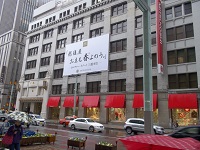 On March 20, when I went to the ground from the subway "Mitsukoshi-mae", a large hanging advertisement on the wall of the department store "Echigo-ya, Onushimo Spring Yonou" On March 20, when I went to the ground from the subway "Mitsukoshi-mae", a large hanging advertisement on the wall of the department store "Echigo-ya, Onushimo Spring Yonou"
This is a playful and stylish copy that makes you look shiny even if you are not a historical drama fan. Ryuishi, I was a little happy to be able to afford the large store Echigoya, and as I walked on, I saw a new view opposite the street.
Today's Coredo Muromachi 2-3, the grand opening. Despite the unfortunate rain, there is a great crowd. I'm worried about what kind of shops are in, but I'm sure I'm looking for it. To TOHO Cinemas Nihonbashi, the first cinema complex in the Nihonbashi area. It is choledo Muromachi 2. If you buy a ticket here on the second floor at the entrance and wait in the lobby, there will be an announcement on the start of guidance to each screening floor 10 minutes before the start of the screening. After all, there are 9 screens. Listen to the announcement of the start of entry and order drinks (Note: Drinks are not sold on the screening floor). The screening floor is on the 3rd to 5th floors. I go to the 5th floor, a movie version of "Nihonbashi" by Kyoka Izumi, starring, directed, and edited by Tamasaburo. It will be open to the public from the 21st, but it will be a preliminary screening in line with the opening of the building. I'm watching the stage of the Nissei Theater in December 2012, but every time I saw the information of "Cinema Kabuki", I wanted to see how it was different from the stage and the movie, so it was just a good opportunity I ran. Since it was not Kabuki, it was called "Grand Cinema" and "Shoot the entire film in a theater without spectators". The cast below Tamasaburo is the same as the stage. The impression after watching is natural, but "stage" and "movie" are different. There are many ups and it's impressive. It's this up that I think it's hard for actresses, but Tamasaburo is still beautiful. It may be said that it is unique to a movie that you can clearly see even the pattern and texture of the kimono and the painting of small items such as hot water only. It feels unsatisfactory that there is no response to the excitement of the expectation of waiting for the audience seats at the theater or the reaction to the performance, but it was troublesome to applaud by hearing the shy pumps. I recommend you to see it now. It's not a good idea to enjoy Nihonbashi in the new Nihonbashi Muromachi. If you have time, it may be a good idea to go to the "Jizo on the West Riverside", which appears many times. Next time, I would like to go out to the shop slowly.
 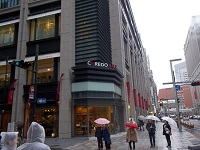
1.
March 15, 2014 09:00
We went to theater to see the hot topic of the two "parallel riders". I misunderstood the release date and applied in a hurry, and it was almost full. The Osaka performance in April is also sold out. 。 。 You can see the high expectations for the new work of "Super Kabuki". It is still remembered that the third generation Sarunosuke's first work, Yamato Takeru, was performed in February 1986, a long run for 10 months and a mobilization of 500,000 people. I think there are many people. In the Nikkei "My Resume" last month, which became a hot topic, Sarunosuke wrote this and that until the performance. Then 28 years ...
 When the curtain opens and the lighting is turned on, it is a “mouth” of actors in a light yellow mosaic. The contemporary drama actors of Kuranosuke Sasaki, Seiji Fukushi and Kazuyuki Asano line up in the Sawayaya of Ukon, Shoya, Shozaburo, and Saruya-san lined up in a row and applauded the audience! "The face is pale in the cold sweat" and Kuranosuke Sasaki makes me laugh. When the curtain opens and the lighting is turned on, it is a “mouth” of actors in a light yellow mosaic. The contemporary drama actors of Kuranosuke Sasaki, Seiji Fukushi and Kazuyuki Asano line up in the Sawayaya of Ukon, Shoya, Shozaburo, and Saruya-san lined up in a row and applauded the audience! "The face is pale in the cold sweat" and Kuranosuke Sasaki makes me laugh.
The work and production are popular Tomohiro Maekawa. The story is a story of friendship and growth between a young Buddhist priest Towa (Sarunosuke), who is worried about the meaning of carving Buddha statues in the Heian period, and a childhood friend Kazuma (Kuranosuke Sasaki), who goes to the capital to save farmers and becomes an official. . According to an interview with Sarunosuke, the name "II Second" is "Not assimilation between Kabuki and contemporary drama, but by holding hands independently with each other, new things are born." The long-awaited "smoky ride" Sarunosuke is used to it, but it is "for the first time" for Kuranosuke Sasaki, who first appeared in Kabuki. Since it was the 8th day, it seems that there was a little room, and when two people joined hands and swim in the air, they applauded again. It's a very long swim and a big service. After the air ride, the stage moves around narrowly with a sense of speed with the physical ability of the "Large standing" flow. It's amazing! That's a word. Applause and curtain call first. Even so, Mr. Kuranosuke, "white paint" is too decided! That's right. The standing figure is also dignified, and it is a "stage shine" that seems to be a very "Kabuki first appearance". Shoya's female thieves is also cool, and you can enjoy it without complaining.
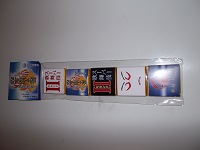
Please take a look at the first work of "Super Kabuki II".
Limited edition chocolate (500 yen) commemorating the performance is until the 29th.
Tickethon Shochiku 0570-000-489 (10:00-18:00)
1.
March 7, 2014 14:00
The first noon of February old calendar is March 12 this year, but most of the first day of February and the second day of the year are held in the new calendar, so it is the coldest season of the year. In old calendar, the first noon seems to have been around a little bit of spring.
One of the three major Inari, Kasama Inari, will hold the first day festival in both the new and lunar calendars. In the Edo period, it was said that there were many days when I entered Terakoya during the "starting" period. According to the bestseller "Why Yahata Shrine is the most common in Japan?", 2070 shrines claim to be "Inari-sha", but if you put auxiliary shrine subsidiary shrine and small shrines in the city, you should actually have the largest Inari." "Inari, which was originally a god of fertility, gradually gained religion as a god of fishing, a god of thriving business, and in the Kanto region, it became widely known as a mansion god, and it was called "fire, fight, Iseya, Inari and dog droppings." It is said that many Inari was recommended. " ("Japanese calendar and annual events").
In the Edo period, Inari was always enshrined in the playhouse in hope of "great entry and prayer for safety," and at the first noon of February, the Inari Festival was held in backstage as an annual event, and all of them were managed and hosted by the large room actors with rooms nearby. (There is another theory.) Edo Sanza also rituals Inari Daimyojin in backstage, and Nakamuraza is "Ginkgo Inari Daimyojin"! Ichimura-za was "Otsu Inari Daimyojin" (for some reason there was no Morita-za), and Inari Daimyojin, who was inspired by "prosperity of business" and "pray for safety," would have been suitable for the play guardian angel in every sense.
Even today, Inari is enshrined in the theater where Kabuki is performed. The following photos are Kabukiza Theater Kabuki Inari Daimyojin, Shimbashi Enbujo, theater Inari Daimyojin, and Meijiza Inari. Kabukiza and Shimbashi Enbujo are the shrine parishioner of Tepposhu Inari Shrine. It seems that the Inari of Meijiza was recommended for Kasama Inari. Inari at the National Theater asked for Inari at Hanazono-jinja Shrine on a backyard tour for members. It's near the arrival board at the entrance of backstage. Why don't you visit Inari at the theater for a while at the theater? You can visit at any time except for the National Theater. (theater Inari is behind the ticket office.)
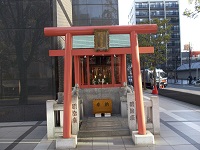 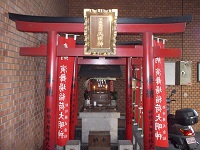
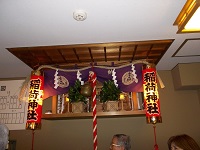 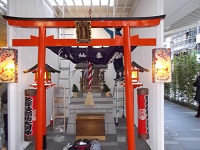
1.
March 6, 2014 14:00
I went to the topic "Guritogura Exhibition". "Mido" was introduced at the beginning of February, so you may know the details, but today, one week before the end of the exhibition, there is a person and person who took a commemorative photo with a mobile phone or digital camera in front of the entrance of the venue . When I asked the person in charge at the entrance, he said, "Saturdays and Sundays were even more amazing." The most prominent visitors are young women in their 20s and 30s and moms with infants, and the combination of quite older people with grandchildren. You can see a wide range of fan base of "Guritogura". The original drawing corner from the 7 works is divided and you can immerse yourself in the world of each work. A very enjoyable conversation video between Hayao Miyazaki and Rieko Nakagawa, a reading corner is set up at a spacious counter near the exit, where you can freely read works, and it is young women who are enjoying playing carta . The atmosphere of kindergarten and nursery school play time. You can also enjoy goods such as cards, cartas, handkerchiefs, picture books, and merchandise corners at the exit. It would be nice to have a lot of cashier booths so that visitors can not wait. "Guritogura" is printed in 196! It was a great place.
The design of the admission ticket is different, so that's right. This is the shape of a large egg that can be found. I was able to hear the playfulness of the exhibition planner and it became fun to this point. It seems that the daytime on Weekday is relatively free.
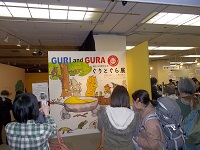 
Until March 10, Matsuya Ginza 8F Event Square 10:00 ~ 20:00 on the last day closes at 17:00.
1
|
Links
|
 On March 20, when I went to the ground from the subway "Mitsukoshi-mae", a large hanging advertisement on the wall of the department store "Echigo-ya, Onushimo Spring Yonou"
On March 20, when I went to the ground from the subway "Mitsukoshi-mae", a large hanging advertisement on the wall of the department store "Echigo-ya, Onushimo Spring Yonou"





